Beryllium Market Size and Share
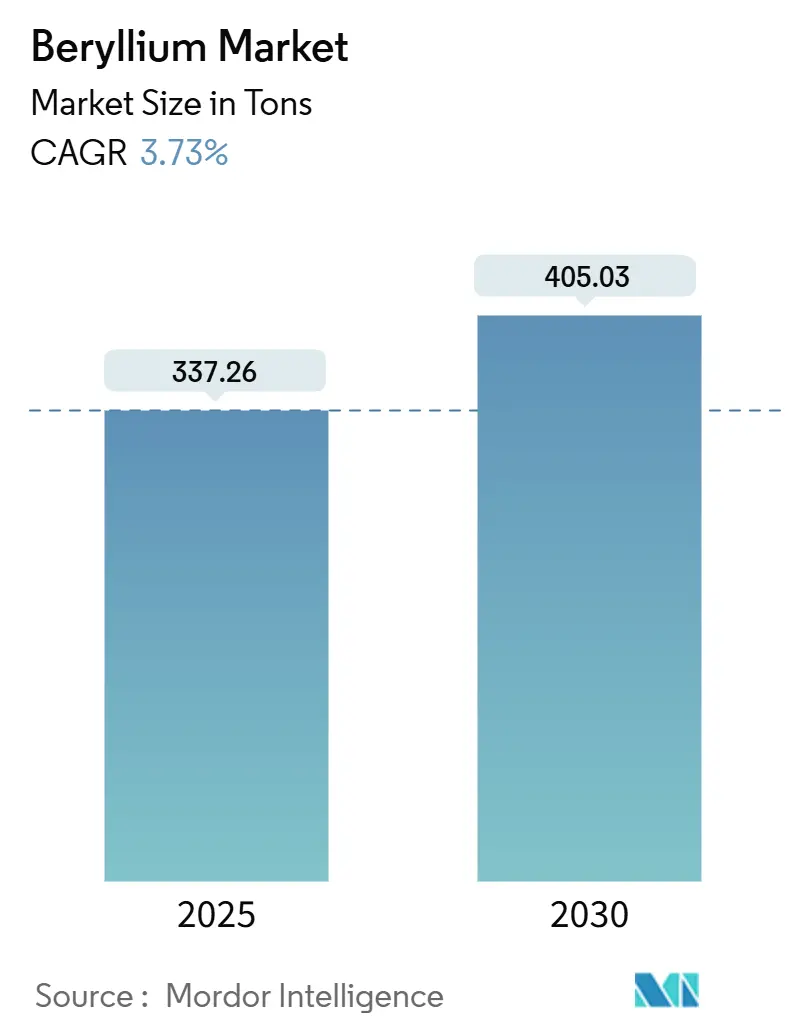
Beryllium Market Analysis by Mordor Intelligence
The Beryllium Market size is estimated at 337.26 tons in 2025, and is expected to reach 405.03 tons by 2030, at a CAGR of 3.73% during the forecast period (2025-2030). Robust growth stems from the metal’s unmatched stiffness-to-weight ratio, superior thermal conductivity, and neutron transparency that position it as a linchpin material across defense, aerospace, electronics, and nascent clean-energy systems. Rising 5G infrastructure roll-outs, reusable launch vehicle programs, and advanced power-electronics platforms elevate demand, while tightening occupational-exposure rules and supply-chain concentration in Kazakhstan and China create cost and security pressures. Strategic integration efforts by U.S. producers strengthen domestic resilience even as Asia-Pacific leads consumption. Competitive differentiation centers on alloy innovation, powder-metallurgy processing, and rapid-prototyping capability that deliver lighter, more durable components for high-value applications.
Key Report Takeaways
- By product type, alloys held 73.43% of the beryllium market share in 2024 and are advancing at a 4.08% CAGR through 2030, underscoring their dual leadership in scale and growth.
- By end-user industry, electronics and telecommunications commanded 29.27% revenue in 2024, while automotive exhibits the fastest expansion at 5.17% CAGR to 2030, owing to electric-vehicle thermal-management needs.
- By geography, Asia-Pacific contributed 37.90% volume in 2024 and is forecast to retain the highest regional growth at 4.20% CAGR on the back of 5G base-station deployment and electronics manufacturing depth.
Global Beryllium Market Trends and Insights
Driver Impact Analysis
| Drivers | (~) % Impact on CAGR Forecast | Geographic Relevance | Impact Timeline |
|---|---|---|---|
| Rising adoption of Be-Cu alloys in 5G and mmWave base-station RF filters | +1.2% | Global with Asia-Pacific leadership | Medium term (2-4 years) |
| Growing requirement for lightweight, high-stiffness structures in reusable launch vehicles | +0.8% | North America and Europe, expanding to Asia-Pacific | Long term (≥ 4 years) |
| Escalating demand for thermal-management materials in advanced EV power electronics | +0.9% | Global, early adoption in Europe and China | Medium term (2-4 years) |
| Defense modernization programs boosting satellite, missile-seeker and optical-sensor volumes | +0.6% | North America, Europe, Asia-Pacific | Long term (≥ 4 years) |
| Emerging need for neutron-transparent Be reflectors in small modular reactors | +0.3% | North America, Europe with potential Asia-Pacific expansion | Long term (≥ 4 years) |
| Source: Mordor Intelligence | |||
Rising Adoption of Be-Cu Alloys in 5G And mm-wave Base-Station RF Filters
Global 5G roll-outs drive unprecedented volumes of high-frequency RF connectors that mandate copper-beryllium for its simultaneous electrical, mechanical, and corrosion-resistant performance. Each mmWave base station uses more Be-Cu per node than 4G equipment, multiplying overall consumption. Continuous processing improvements now yield ultra-thin precision strip essential for 24 GHz-plus systems. Because 5G infrastructure is classified as critical national infrastructure, security-of-supply considerations amplify strategic interest in the beryllium market. Asia-Pacific remains the demand epicenter, yet North American and European operators maintain stringent specifications that favor high-purity alloys.
Growing Requirement for Lightweight, High-Stiffness Structures in Reusable Launch Vehicles
The shift from expendable to reusable launch systems hinges on materials that survive repeated thermal and vibrational extremes without mass penalties. Beryllium’s specific stiffness is six times that of steel at one-quarter the weight, enabling lighter optical benches, sensor mounts, and structural panels. Beryllium-aluminum composites such as AlBeMet and Beralcast deliver dimensional stability across temperature swings, validated by the performance of the James Webb Space Telescope mirror segments. As commercial launch providers target hundreds of sorties per year, demand for durable beryllium components scales in tandem.
Escalating Demand for Thermal-Management Materials in Advanced EV Power Electronics
Premium battery-electric vehicles increasingly shift to 800 V systems, intensifying heat dissipation challenges. Beryllium-oxide ceramics, boasting thermal conductivity near 325 W/mK, allow compact inverter and charger modules while aligning thermal expansion with silicon-carbide semiconductors[1]Microwave/RF, “BeO Takes the Heat in RF Transistor Packages,” mwrf.com. These substrates mitigate thermal runaway, a safety imperative accelerating regulatory support in Europe and China. Automotive OEMs thereby transition from price-driven material selection toward performance-critical solutions, directly boosting the beryllium market demand.
Defense Modernization Programs Boosting Satellite, Missile-Seeker and Optical-Sensor Volumes
Militaries invest in higher-resolution imaging and faster missile-seeker updates, both of which capitalize on beryllium’s dimensional stability across broad temperature bands. Missile guidance assemblies, satellite bus structures, and neutron-detection devices rely on the metal’s unique neutron properties that remain technically non-substitutable. Next-generation sensor platforms specify increasingly pure beryllium grades, expanding premium-priced niches within the beryllium market.
Restraint Impact Analysis
| Restraints | (~) % Impact on CAGR Forecast | Geographic Relevance | Impact Timeline |
|---|---|---|---|
| Stringent occupational-exposure limits and rising compliance costs | -0.7% | Global with strictest enforcement in North America and Europe | Short term (≤ 2 years) |
| Volatility of beryllium concentrate supply from Kazakhstan and China | -0.5% | Global, acute in Asia-Pacific manufacturing | Medium term (2-4 years) |
| Accelerating research on aluminum and titanium metal-matrix composites as substitutes | -0.4% | North America and Europe | Long term (≥ 4 years) |
| Source: Mordor Intelligence | |||
Stringent Occupational-Exposure Limits and Rising Compliance Costs
OSHA cut permissible exposure thresholds from 2 µg/m³ to 0.2 µg/m³, obligating producers to install enhanced ventilation, isolation, and medical-surveillance systems that elevate unit costs[2]Occupational Safety and Health Administration, “Beryllium – Standards,” osha.gov. Europe applies comparable restrictions under REACH authorization, further tightening the regulatory envelope. Smaller processors struggle to absorb these expenses, accelerating industry consolidation and raising entry barriers that constrain overall supply expansion.
Volatility of Beryllium Concentrate Supply from Kazakhstan and China
Kazakhstan’s Ulba Metallurgical Plant and select Chinese facilities produce most global concentrates outside the United States. Reserves based on Cold-War-era stockpiles are depleting, and geopolitical frictions threaten exports. Any disruption swiftly affects Asia-Pacific fabricators that depend on imported concentrates, highlighting supply-security concerns embedded within the beryllium market.
Segment Analysis
By Product Type: Alloys Drive Innovation Across Applications
Alloys captured 73.43% of the beryllium market share in 2024 and are projected to expand at a 4.08% CAGR through 2030, confirming their central role in high-performance platforms. Within this category, copper-beryllium alloys dominate telecommunications connectors, while aluminum-beryllium metal-matrix composites unlock weight savings in aerospace structures. Because alloy formulations can be tuned for strength, conductivity, or thermal properties, producers devote significant research and development budgets to new compositions that address emerging design constraints.
Pure metal continues to serve nuclear reflectors and space-optics segments where alloying would impair neutron or thermal performance. Beryllium-oxide ceramics fill niche but critical positions in high-density power modules that require extreme thermal conductivity. Powder-metallurgy advances and hot-isostatic-pressing routes enable intricate geometries unprecedented a decade ago, underscoring how alloy progress propels overall beryllium market momentum.
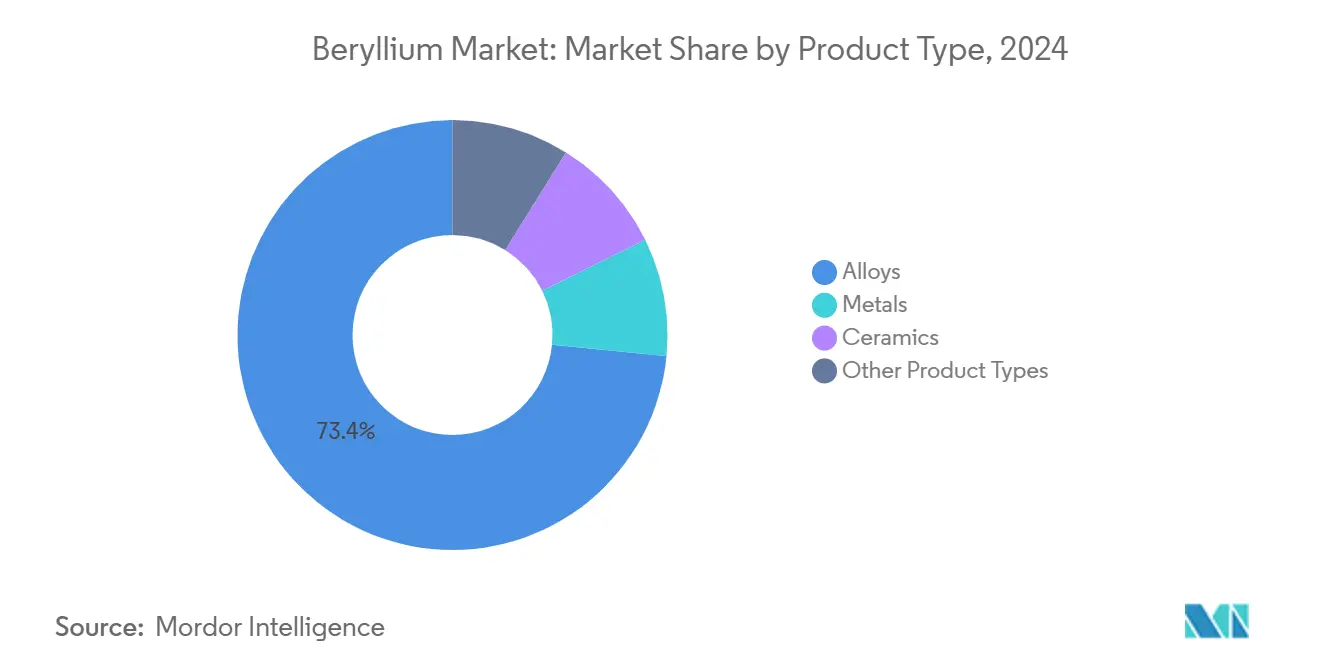
Note: Segment shares of all individual segments available upon report purchase
By End-User Industry: Electronics Lead While Automotive Accelerates
Electronics and telecommunications retained 29.27% revenue in 2024 as 5G and data-center investments incorporate Be-Cu connectors, springs, and switch components that withstand high-frequency cycling. Automotive, however, posts the fastest 5.17% CAGR through 2030 because electric-vehicle makers depend on Be-O substrates and Be-Al heat spreaders that safeguard power electronics at elevated voltages.
Aerospace and defense remain foundational, consuming high-purity grades for satellite mirrors and missile guidance assemblies where even minute dimensional drift jeopardizes mission success. Healthcare applications include X-ray windows and advanced imaging detectors that exploit beryllium’s X-ray transparency. Industrial tooling and oil-and-gas components add steady baseline demand via corrosion-resistant, high-strength alloy parts. This widening adoption across civilian sectors diversifies the beryllium market, reducing cyclical exposure to defense spending.
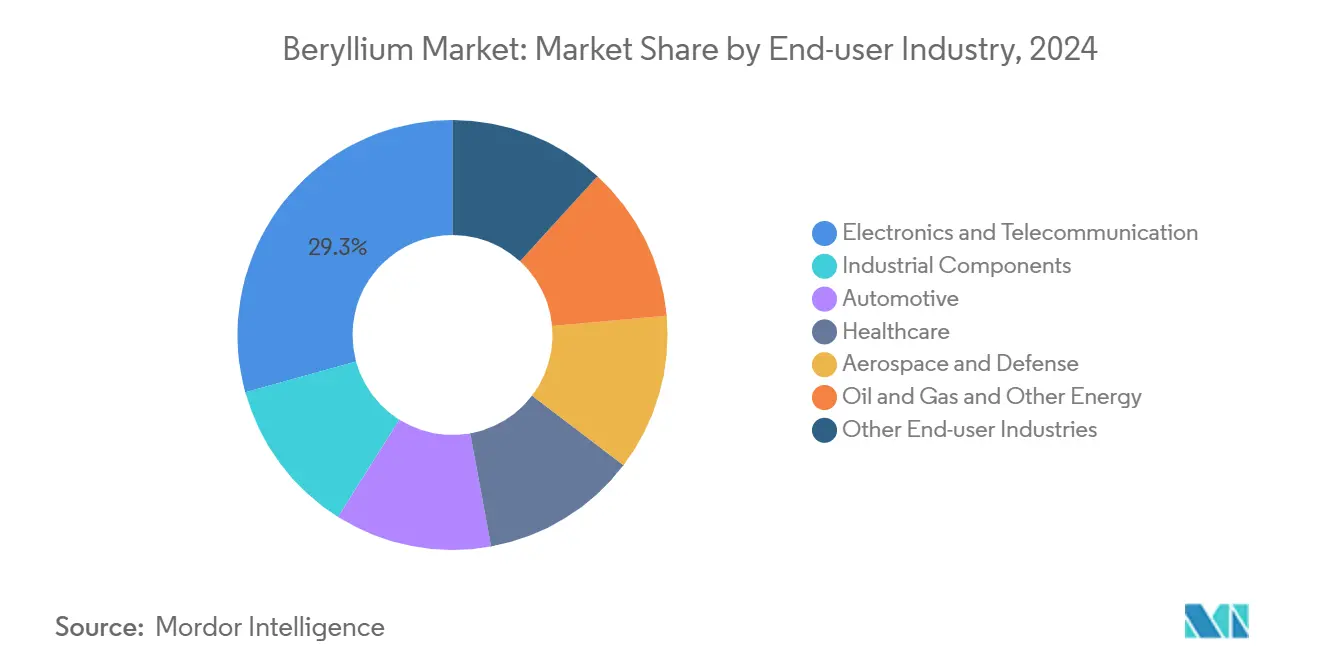
Note: Segment shares of all individual segments available upon report purchase
Geography Analysis
Asia-Pacific generated 37.90% of 2024 volume and is forecast to log a 4.20% CAGR through 2030 as China spearheads electronics production and 5G base-station deployment. Domestic processors integrate upstream concentrate and downstream alloying, sustaining a largely closed supply loop that buffers local consumers from international volatility. Japan and South Korea contribute sizeable volumes through automotive electrification and high-precision semiconductor tooling, while India’s expanding space program lifts regional aerospace demand.
North America anchors supply-chain resilience with the world’s only fully integrated mine-to-mill operation at Materion’s Utah-Ohio complex. Mature aerospace and defense sectors ensure stable base load consumption, and the Inflation Reduction Act incentives bolster domestic EV battery and power-electronics manufacturing that rely on Be-O substrates. Canada and Mexico add incremental growth via aerospace assembly and emerging EV export hubs.
Europe balances stringent occupational regulations with robust application demand. The continent’s accelerated EV adoption and renewable-energy build-out intensify requirements for high-performance thermal-management materials, favoring beryllium alloys and ceramics. NGK Berylco France pioneers lower-carbon processing routes aligned with EU sustainability goals. While Middle East–Africa and South America remain smaller markets, new processing ventures such as BerylTech Rwanda illustrate early steps toward geographic diversification.
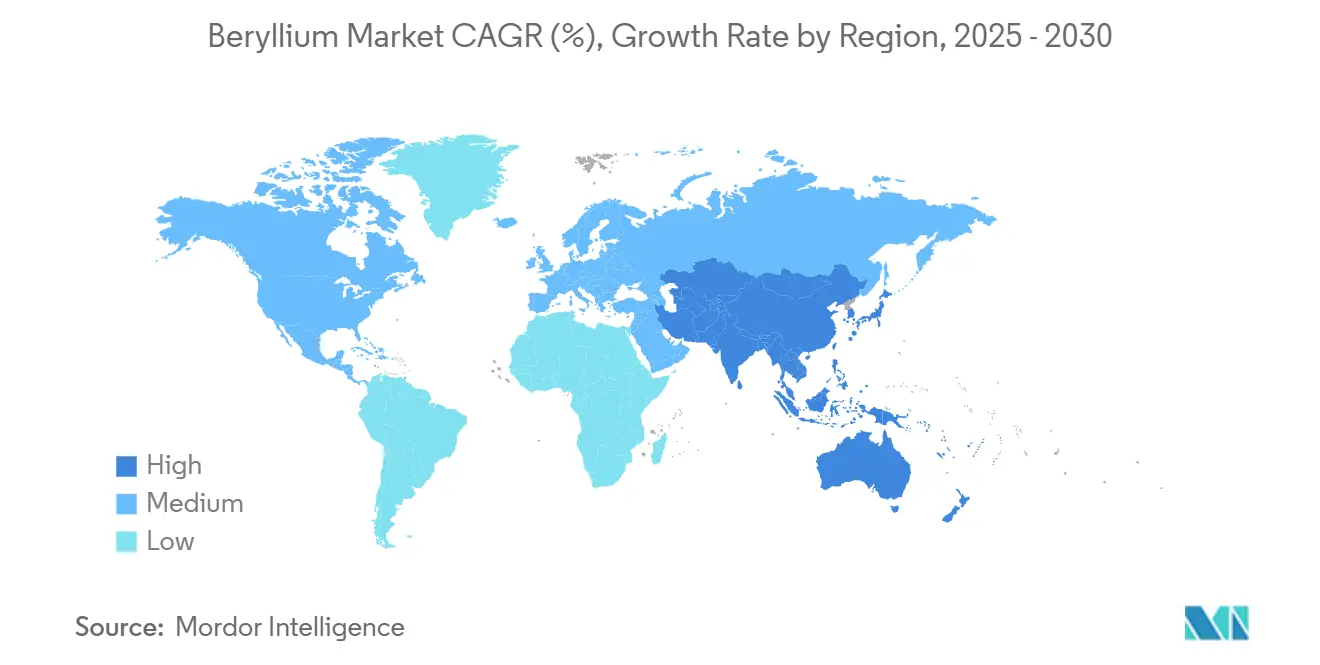
Competitive Landscape
The market is consolidated in nature. Materion commands a vertically integrated position that spans Spor Mountain mining, proprietary powder metallurgy, and finished component fabrication. The company’s reserves secure roughly 70 years of domestic ore, safeguarding U.S. strategic supply lines and enabling quick-turn alloy development for defense, telecom, and space customers. Technology differentiation revolves around composition tailoring, grain-structure control, and near-net-shape manufacturing that cuts machining waste. Recent patent filings focus on low-temperature powder-consolidation methods and grain-boundary strengthening additives for Be-Al composites.
Beryllium Industry Leaders
-
Materion Corporation
-
Hunan Shuikoushan Nonferrous Metals Group Co., Ltd.
-
IBC Advanced Alloys
-
JSC Ulba Metallurgical Plant (JSC NAC Kazatomprom)
-
NGK INSULATORS, LTD.
- *Disclaimer: Major Players sorted in no particular order
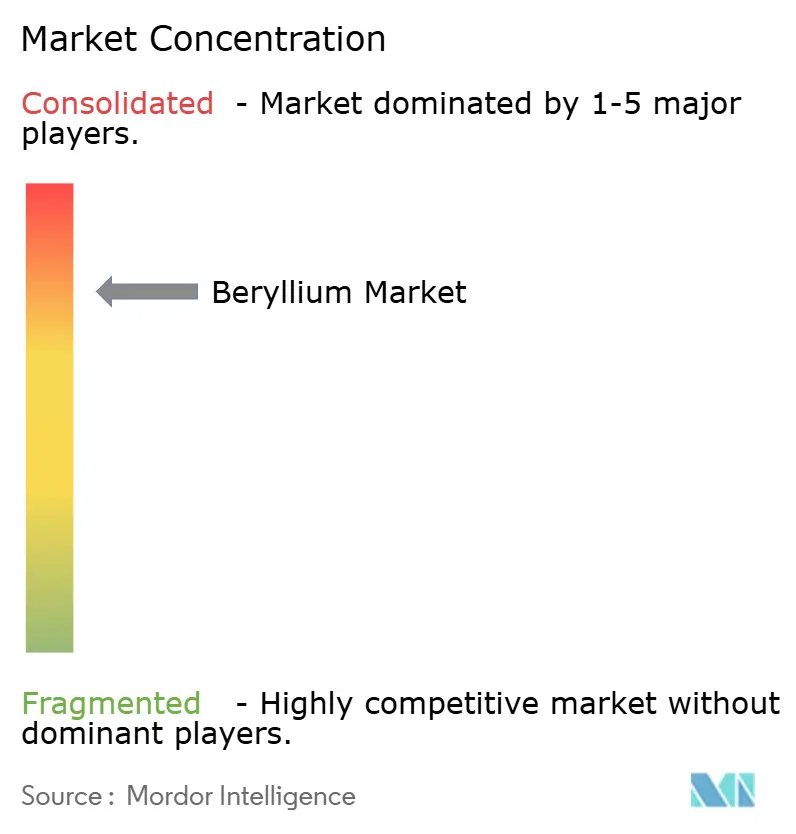


Recent Industry Developments
- March 2025: Rockland Resources Ltd. acquired the Claybank Beryllium Project near Utah’s Spor Mountain, enlarging North American resource potential
- January 2025: Materion expanded AlBeCast aluminum-beryllium casting capacity at Elmore, Ohio, incorporating advanced rapid-prototyping lines to support aerospace and defense contracts.
Global Beryllium Market Report Scope
Beryllium is a hard, light, silver-grey metal with chemical properties similar to aluminum. It is brittle at room temperature. It is used to make strong alloys and finds application in industrial components, aerospace and defense, electronics, etc.
The beryllium market is segmented by product type, end-user industry, and geography. By product type, the market is segmented into alloys, metals, ceramics, and other product types. By end-user industry, the market is segmented into industrial components, automotive, healthcare, aerospace and defense, oil and gas, electronics and telecommunications, and other end-user industries. The report covers the market sizes and forecasts for the global beryllium market in 27 countries across major regions. For each segment, the market sizing and forecasts are done based on volume in tons.
| Alloys |
| Metals |
| Ceramics |
| Other Product Types |
| Industrial Components |
| Automotive |
| Healthcare |
| Aerospace and Defense |
| Oil and Gas and Other Energy |
| Electronics and Telecommunication |
| Other End-user Industries |
| Asia-Pacific | China |
| Japan | |
| India | |
| South Korea | |
| Rest of Asia-Pacific | |
| North America | United States |
| Canada | |
| Mexico | |
| Europe | Germany |
| United Kingdom | |
| France | |
| Italy | |
| Russia | |
| Rest of Europe | |
| South America | Brazil |
| Argentina | |
| Rest of South America | |
| Middle-East and Africa | Saudi Arabia |
| South Africa | |
| Rest of Middle-East and Africa |
| By Product Type | Alloys | |
| Metals | ||
| Ceramics | ||
| Other Product Types | ||
| By End-user Industry | Industrial Components | |
| Automotive | ||
| Healthcare | ||
| Aerospace and Defense | ||
| Oil and Gas and Other Energy | ||
| Electronics and Telecommunication | ||
| Other End-user Industries | ||
| By Geography | Asia-Pacific | China |
| Japan | ||
| India | ||
| South Korea | ||
| Rest of Asia-Pacific | ||
| North America | United States | |
| Canada | ||
| Mexico | ||
| Europe | Germany | |
| United Kingdom | ||
| France | ||
| Italy | ||
| Russia | ||
| Rest of Europe | ||
| South America | Brazil | |
| Argentina | ||
| Rest of South America | ||
| Middle-East and Africa | Saudi Arabia | |
| South Africa | ||
| Rest of Middle-East and Africa | ||


Key Questions Answered in the Report
How large is the beryllium market in 2025?
The 2025 beryllium market size is 337.26 tons, with a forecast to reach 405.03 tons by 2030.
What is driving volume growth over the next five years?
Key drivers are 5G base-station roll-outs, reusable launch vehicles, advanced EV power electronics, and defense modernization programs.
Which product segment leads demand?
Alloys account for 73.43% of 2024 volume and are also the fastest-growing at a 4.08% CAGR through 2030.
Why is Asia-Pacific so dominant?
Asia-Pacific hosts leading electronics and telecom manufacturing bases and was responsible for 37.90% of global volume in 2024, with China integrating upstream and downstream operations.
How strict are current safety regulations?
OSHA limits workplace exposure to 0.2 µg/m³, forcing comprehensive ventilation and medical-surveillance investments across production and downstream fabrication sites.
Page last updated on:









